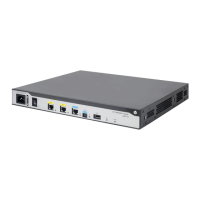175
Configuring load sharing
If a routing protocol finds multiple equal-cost best routes to the same destination, the device forwards
packets over the equal-cost routes to implement load sharing.
NOTE:
The system allows a maximum of 32 load sharing routes.
Command and hardware compatibility
Commands and descriptions for centralized devices apply to the following routers:
• MSR1002-4/1003-8S.
• MSR2003.
• MSR2004-24/2004-48.
• MSR3012/3024/3044/3064.
• MSR954(JH296A/JH297A/JH298A/JH299A)
Commands and descriptions for distributed devices apply to MSR4060 and MSR4080 routers.
Configuring per-packet or per-flow load sharing
Per-flow load sharing allows the device to forward flows over equal-cost routes. Packets of one flow
travel along the same routes. You can configure the device to identify a flow based on the following
criteria: source IP address, destination IP address, source port number, destination port number, and
IP protocol number.
In a complex network, when these criteria cannot distinguish flows, you can use the algorithm
keyword to specify an algorithm to identify flows for load sharing.
To configure per-flow load sharing:
Step Command Remarks
1. Enter system view.
system
-
view
N/A
2. Configure load sharing.
• Centralized devices in standalone mode:
ip load-sharing mode { per-flow
[ dest-ip | dest-port | ip-pro | src-ip |
src-port ] * ]
• Distributed devices in standalone
mode/centralized devices in IRF mode:
ip load-sharing mode { per-flow
[ dest-ip | dest-port | ip-pro | src-ip |
src-port ] * ] | per-packet } [ slot
slot-number ]
• Distributed devices in IRF mode:
ip load-sharing mode { per-flow |
[ dest-ip | dest-port | ip-pro | src-ip |
src-port ] * ] | per-packet } [ chassis
chassis-number slot slot-number ]
By default, load sharing is
disabled.

